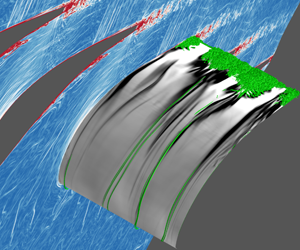Crossref Citations
This article has been cited by the following publications. This list is generated based on data provided by
Crossref.
Dupuy, D.
Gicquel, L.
Odier, N.
Duchaine, F.
and
Arts, T.
2020.
Analysis of the effect of intermittency in a high-pressure turbine blade.
Physics of Fluids,
Vol. 32,
Issue. 9,
Li, Zhihui
and
Agarwal, Ramesh K.
2021.
Investigation of endwall effect on transitional flow inside compressor cascade passage at low Reynolds number.
Physics of Fluids,
Vol. 33,
Issue. 11,
Qu, Xiao
Zhang, Yingjie
Lu, Xingen
Zhu, Junqiang
and
Zhang, Yanfeng
2021.
Unsteady fluidic oscillators for active controlling boundary layer separation in an ultra-high-lift low-pressure turbine.
Aerospace Science and Technology,
Vol. 119,
Issue. ,
p.
107130.
Wang, Rui
and
Xiao, Zuoli
2021.
Influence of free-stream turbulence on the aerodynamic performance of a three-dimensional airfoil.
AIP Advances,
Vol. 11,
Issue. 7,
Srivastava, Vishal
and
Duraisamy, Karthik
2021.
Generalizable physics-constrained modeling using learning and inference assisted by feature-space engineering.
Physical Review Fluids,
Vol. 6,
Issue. 12,
Sandberg, Richard D.
and
Michelassi, Vittorio
2022.
Fluid Dynamics of Axial Turbomachinery: Blade- and Stage-Level Simulations and Models.
Annual Review of Fluid Mechanics,
Vol. 54,
Issue. 1,
p.
255.
Dotto, A.
Barsi, D.
Lengani, D.
Simoni, D.
and
Satta, F.
2022.
Effect of free-stream turbulence properties on different transition routes for a zero-pressure gradient boundary layer.
Physics of Fluids,
Vol. 34,
Issue. 5,
Wang, Xiaoning
Wang, Jianchun
and
Chen, Shiyi
2022.
Compressibility effects on statistics and coherent structures of compressible turbulent mixing layers.
Journal of Fluid Mechanics,
Vol. 947,
Issue. ,
Lengani, D.
Simoni, D.
Pralits, J.O.
Đurović, K.
De Vincentiis, L.
Henningson, D.S.
and
Hanifi, A.
2022.
On the receptivity of low-pressure turbine blades to external disturbances.
Journal of Fluid Mechanics,
Vol. 937,
Issue. ,
Sandberg, Richard D.
and
Zhao, Yaomin
2022.
Machine-learning for turbulence and heat-flux model development: A review of challenges associated with distinct physical phenomena and progress to date.
International Journal of Heat and Fluid Flow,
Vol. 95,
Issue. ,
p.
108983.
Verdoya, J.
Dellacasagrande, M.
Barsi, D.
Lengani, D.
and
Simoni, D.
2022.
Identification of free-stream and boundary layer correlating events in free-stream turbulence-induced transition.
Physics of Fluids,
Vol. 34,
Issue. 1,
Xu, Haosen H. A.
Lynch, Stephen
and
Yang, Xiang I. A.
2022.
Direct numerical simulation of slot film cooling downstream of misaligned plates.
Flow,
Vol. 2,
Issue. ,
Wu, Jiafeng
Jiang, Hanbo
Ma, Zhaokai
Chen, Wangqiao
and
Huang, Xun
2022.
Numerical investigation of airfoilrotor interaction at low Reynolds number.
Physics of Fluids,
Vol. 34,
Issue. 2,
Cassinelli, Andrea
Mateo Gabín, Andrés
Montomoli, Francesco
Adami, Paolo
Vázquez Díaz, Raul
and
Sherwin, Spencer J.
2022.
Reynolds Sensitivity of the Wake Passing Effect on a LPT Cascade Using Spectral/hp Element Methods.
International Journal of Turbomachinery, Propulsion and Power,
Vol. 7,
Issue. 1,
p.
8.
Wu, Xiaohua
2023.
New Insights into Turbulent Spots.
Annual Review of Fluid Mechanics,
Vol. 55,
Issue. 1,
p.
45.
Fava, T. C. L.
Lobo, B. A.
Nogueira, P. A. S.
Schaffarczyk, A. P.
Breuer, M.
Henningson, D. S.
and
Hanifi, A.
2023.
Numerical study of the hydrodynamic stability of a wind-turbine airfoil with a laminar separation bubble under free-stream turbulence.
Physics of Fluids,
Vol. 35,
Issue. 8,
Liu, Yaoyao
Pan, Chong
and
Liu, Jianhua
2023.
Intermittent behavior of a bypass transition of boundary layers over an axisymmetric body of revolution.
Ocean Engineering,
Vol. 286,
Issue. ,
p.
115689.
Jelly, Thomas O.
Nardini, Massimiliano
Rosenzweig, Marco
Leggett, John
Marusic, Ivan
and
Sandberg, Richard D.
2023.
High-fidelity computational study of roughness effects on high pressure turbine performance and heat transfer.
International Journal of Heat and Fluid Flow,
Vol. 101,
Issue. ,
p.
109134.
Kozul, Melissa
Nardini, Massimiliano
and
Sandberg, R. D.
2023.
Direct numerical simulation of high-pressure turbine blades subject to burner-like inlet temperature variations
.
p.
11.
Wang, Taiyang
Zhao, Yaomin
Leggett, John
and
Sandberg, Richard D.
2023.
Direct Numerical Simulation of a High-Pressure Turbine Stage: Unsteady Boundary Layer Transition and the Resulting Flow Structures.
Journal of Turbomachinery,
Vol. 145,
Issue. 12,





